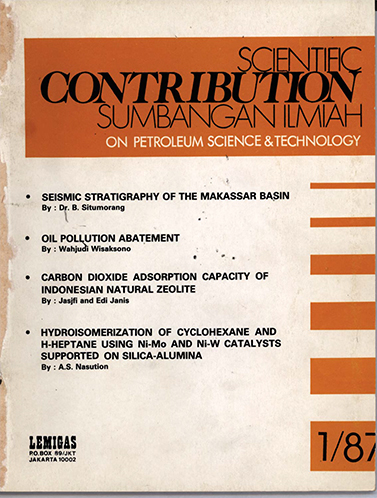HYDROISOMERIZATION OF CYCLOHEXANE AND N-HEPTANE USING Ni-Mo AND Ni-W CATALYSTS SUPORTED ON SILICA-ALUMINA
DOI:
https://doi.org/10.29017/SCOG.10.1.1156Keywords:
Hydroisomerization, Cyclohexane, Silica-AluminaAbstract
An experiment has been carried out to study the influence of hydrogenating site of bi-functional and of butylamine on the hydroisomerization cyclohexane and n-heptane. The observed data show that a high activity of hydrogenating ste of bi-functional catalyst, tends to increase the cataly tic activity of hydroisomeri- zation reaction and n-butylamine acts as catalyst poison, which reduces the isomer products.
Â
References
Ahusa, Etudes des Catalyseours d'hydrotreat- ment, These Universite de Paris, December 2, 1967.
A.S. Nasution, Papers : on 2nd ASCOPE Con- ference and Exhibition, Manila, Philipines, October 7-11, 1981; and on 3rd International Congress on Catalyst, West Berlin, West-Ger- many, July 2 - 6, 1984.
Asselin, G.F., and Erickson, R.A., Chem. Eng. Prog. 58, No. 4, 47 (1962).
Charles L. Thomas, Cataly tic Processes and Proven Catalysts, Academic Press, New York, 1970, p. 15-23.
C. Kenneth Viland., Petroleum Refiner, vol 37 (3), 197 (March, 1958)
G.D. Hobson, Modern Petroleum Technology, Applied Science Publisher Ltd, England, 1973, p. 309-327.
M.H. Mizcha, et all, Khim, Tekhnol. Topliv i Masel, No. 4, 23 -25 (1961)
Downloads
Issue
Section
License
Copyright (c) 1970 SCIENTIFIC CONTRIBUTIONS OIL AND GAS (SCOG)

This work is licensed under a Creative Commons Attribution 4.0 International License.
Authors are free to Share — copy and redistribute the material in any medium or format for any purpose, even commercially Adapt — remix, transform, and build upon the material for any purpose, even commercially.
The licensor cannot revoke these freedoms as long as you follow the license terms, under the following terms Attribution — You must give appropriate credit , provide a link to the license, and indicate if changes were made . You may do so in any reasonable manner, but not in any way that suggests the licensor endorses you or your use.
No additional restrictions — You may not apply legal terms or technological measures that legally restrict others from doing anything the license permits.














